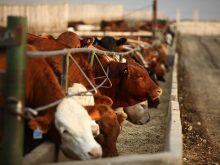Compared to last week, Western Canadian yearling prices were $3 to as much as $10 higher while calves traded $2 to $5 above week-ago levels. Most auction barns remain in holiday mode; however, order buyers were extremely busy fielding calls for available cattle. This caused the yearling market in Western Canada to divorce from the fed cattle trade. Small packages were on offer and major feedlots were very aggressive.
In Central Alberta, larger frame lower flesh black mixed steers weighing just under 900 pounds reached up to $187 while 970 pound steers of similar quality were quoted at $178. Buying interest for heifers wasn’t’ quite as strong but prices were still rather firm. Larger frame mixed heifers weighing 790 pound were quoted at $178 south of Edmonton. In Central Saskatchewan, small groups of medium to larger frame lower flesh heifers weighing 910 to 930 pounds were quoted at $150 to $155. Heifer quality wasn’t up to par with steers so there was a larger variation of prices. Yearling heifers weighing 950 to 970 pounds were quoted from $135 to $145 in Central Alberta and Central Saskatchewan.
Read Also

U.S. livestock: ‘Cattle on feed’ report supports prices
Chicago cattle futures rose as the USDA’s ‘Cattle on Feed’ report showed inventories two per cent down from a year…
The calf market was very hard to define due to the limited numbers. In Central Alberta, steers weighing 500 to 530 pounds in Central Alberta were quoted from $217 to $223 while heifers weighing 500 to 550 pounds were valued in the range of $185 to $195.
Western Canadian yearling supplies are expected to be down five to eight per cent from year-ago levels this fall which has feedlots anxious to secure ownership. Most of Central Alberta and Central Saskatchewan have received 150 to 200 per cent of normal precipitation. Pastures have improved and cow calf operators are not as anxious to liquidate cattle. The yearling market is functioning to attract supplies because there is a fairly optimistic outlook for fed cattle prices in the first quarter of 2020. Western Canada will also experience a sharp year-over-year increase in the barley production resulting in lower input costs this winter.
The U.S. July 1 cattle inventory report showed that the 2019 U.S. calf crop will be similar to last year. Heifers for beef cow replacement were down four per cent from year-ago levels. Feeder cattle supplies are not growing but stabilizing; therefore, don’t expect much slippage in the market this fall.
















